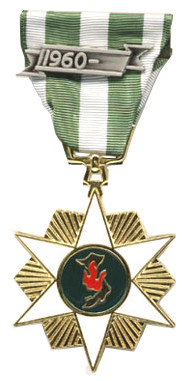U.S. veterans of the Korean War are now eligible to wear a medal initially offered to them more than 50 years ago, but never issued.
In a May 13, 2000 letter to Defense Secretary William S. Cohen, Republic of Korea Defense Minister Seong Tae Cho formally announced that his government would provide the Republic of Korea War Service Medal (ROKWSM) to eligible U.S. veterans of that conflict, or to their surviving next of kin. The medal will be provided at no cost to veterans. The U.S. Air Force has been designated the lead agency to receive and distribute the medals.
"On the occasion of the 50th Anniversary of the Korean War," Cho wrote, "the ROK government decided to issue the ROKWSM to pay tribute to the Korean War veterans for their historic endeavors to preserve freedom of the ROK and the free world." The two governments will conduct fiftieth anniversary ceremonies throughout 2000-2003 and medals may be applied for at any time during this period. The war began on June 25, 1950 when North Korean forces invaded ROK territory. The armistice on July 27, 1953 ended the fighting, although a formal peace treaty has never been completed.
The medal was originally offered by the ROK in 1951 to United Nations forces serving in Korea and adjacent waters. At the time U.S. law prohibited the U.S. military from wearing medals issued by foreign governments. Congress changed that in 1954, but by then most U.S. service members eligible for the medal had returned home.
In 1998 the government of the Republic of Korea renewed its original offer of the ROKWSM to U.S. military personnel. On Aug. 20, 1999, the Defense Department approved the acceptance and wear of the medal. Approximately 1.8 million U.S. veterans of the Korean War are eligible to receive it. Next of kin to eligible deceased veterans can also apply for the medal.
To wear this medal on U.S. military uniforms, U.S. military personnel must have:
· served between the outbreak of hostilities, June 25, 1950, and the date the armistice was signed, July 27, 1953;
· been on permanent assignment or on temporary duty for 30 consecutive days or 60 non-consecutive days; and
· performed their duty within the territorial limits of Korea, in the waters immediately adjacent thereto or in aerial flight over Korea participating in actual combat operations or in support of combat operations.
The ROK specifies the eligibility period and criteria. Only the ROK-provided medal is approved by the U.S. Government to meet the U.S. criteria for wear on the military uniform.
To apply, veterans must provide a copy of their discharge paper, commonly known as a "DD-214," or a corrected version of that document, a "DD-215." National Guard members must provide their statement of service equivalent, "NGB Form 22."
Additional information on how to apply for or request the medal can be found by contacting the Air Force Personnel Center, Monday - Friday, 0730-1630 (CST) at (800) 558-1404, or the Awards and Decorations Section (210) 565-2432/2520/2516, or by writing to HQ AFPC/DPPPRA , 550 C Street West, Suite 12, Randolph Air Force Base, Texas 78150-4714 or by visiting our web site: http://www.afpc.randolph.af.mil/awards/. The organization's fax number is (210) 565-3118.
General information on the medal can also be found by writing the DoD 50th Anniversary of the Korean War Commemoration Committee, 1213 Jefferson Davis Highway, Crystal Gateway 4, Arlington, VA 22202, by calling (703) 604-0831 or by visiting its web site: http://korea50.army.mil.
Because the order of precedence for non-U.S. service medals and ribbons is determined by date of approval, the ROKWSM should be worn after the Kuwait Liberation Medal, which was the last foreign medal approved for wear by U.S. military personnel. For the majority of Korean War veterans the medal will be worn after the United Nations Medal, or the Republic of Vietnam Campaign Medal if they served during that conflict.

